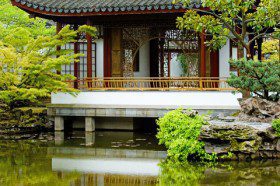Form School Defined: Arranging spaces based on natural landforms to optimize energy flow & harmony
The Form School of Feng Shui has its roots in ancient Chinese philosophy and Taoism. This approach emphasizes the physical features of the environment, such as shapes, landforms, and structures, in analysing the flow of energy. Over time, the Form School principles have evolved to include specific techniques for enhancing positive energy flow and mitigating negative influences in various spaces.
Key Principles of Feng Shui Form School
One of the key principles of the Form School of Feng Shui is the focus on the external environment surrounding a space. By analysing the shapes and landforms, practitioners of Form School Feng Shui seek to understand how energy flows through different settings and how it can be optimized for the benefit of inhabitants. The shapes of buildings, roads, and natural features all play a crucial role in shaping the energy dynamics of a space.
Influence of Geography & Landscape in Form School
Geography and landscape are fundamental considerations in Form School Feng Shui. Mountains and water are believed to have significant influences on the flow of Qi in a particular area. Mountains provide support and protection, while water symbolizes wealth and prosperity. By analysing the interaction of these elements and understanding how Qi flows through different landscapes, practitioners can make informed decisions to enhance the energy balance and overall harmony of a space.
In essence, Form School Feng Shui offers a practical and tangible approach to creating spaces that not only look aesthetically pleasing but also support the wellbeing and success of those who inhabit them.
Applications & Practices in Form School
In the realm of Form School Feng Shui, one of the core practices involves designing layouts and orientations with meticulous attention to the surrounding environment. By strategically placing buildings and structures, practitioners aim to harness the natural energies or “Qi” to create harmonious and beneficial spaces.
Designing Layouts & Orientations
Designing layouts and orientations is at the heart of Form School Feng Shui. It involves carefully considering the topography, landforms, and natural elements surrounding a site to determine the most auspicious placement for buildings. By aligning structures with the flow of qi, practitioners seek to optimize positive energy and enhance the wellbeing of occupants.
Enhancing Energy Flow through Architectural Features
Another key aspect of Form School Feng Shui is the intentional incorporation of architectural features to enhance energy flow within a space. From the strategic placement of doors and windows to the use of specific materials and shapes, every detail plays a crucial role in promoting a balanced and harmonious environment. By harmonizing the built environment with natural forces, practitioners aim to cultivate positive energy and support the occupants’ goals and aspirations.
Notable Masters & Case Studies in Form School Feng Shui
Form School Feng Shui has been shaped by the wisdom and teachings of renowned masters who have made significant contributions to the field. Through their expertise and guidance, practitioners have gained insights into the intricate principles of Feng Shui and learned to apply them in various contexts.
Exploring Contributions of Form School Masters
Form School Feng Shui boasts a rich lineage of masters whose innovative approaches have deepened our understanding of the ancient practice. From the pioneering work of historical figures to the contemporary teachings of modern practitioners, each master has left a lasting impact on the evolution of Form School Feng Shui. By studying their teachings and insights, practitioners can cultivate a deeper appreciation for the intricate interplay between architectural design and energetic principles.
Case Studies Demonstrating Effective Feng Shui Applications
Through case studies and real-life examples, the effectiveness of Form School Feng Shui in enhancing the quality of spaces becomes apparent. From residential homes to commercial buildings, these studies showcase how thoughtful application of Feng Shui principles can transform environments and positively impact the occupants’ wellbeing. By dissecting these case studies, practitioners can gain practical insights into implementing Form School Feng Shui in their own projects.
Modern Interpretations & Adaptations of Form School Feng Shui
In the ever-evolving landscape of design and architecture, Form School Feng Shui continues to find relevance through its integration into modern settings. By adapting traditional principles to contemporary contexts and embracing innovative approaches, practitioners are reshaping the way Feng Shui is applied in today’s world.
Integration of Traditional Principles in Contemporary Settings
One of the key challenges facing practitioners of Form School Feng Shui is adapting traditional principles to suit modern lifestyles and architectural trends. By striking a balance between ancient wisdom and contemporary needs, practitioners can create spaces that resonate with the energy of the present moment while honouring the wisdom of the past. Through this integration, Form School Feng Shui remains a dynamic and relevant practice in today’s design landscape.
Innovative Approaches to Form School Feng Shui Today
As the boundaries of design continue to expand, practitioners of Form School Feng Shui are exploring innovative approaches to integrate ancient principles with cutting-edge technologies. From the use of digital mapping tools to analyse energy flows to the incorporation of sustainable materials and practices, modern interpretations of Form School Feng Shui are pushing the boundaries of what is possible. By embracing innovation and creativity, practitioners are redefining the potential of Feng Shui to create environments that not only look good but also feel good. The Form School of Feng Shui provides a fascinating lens through which to understand the intricate relationship between our surroundings and our wellbeing. By honouring the principles of form, landscape, and energy flow, practitioners of Form School Feng Shui can create spaces that not only promote harmony and balance but also resonate with the natural world. As we continue to appreciate and apply these ancient teachings in our contemporary lives, we embrace the timeless wisdom of Feng Shui in enhancing the quality of our environments and, ultimately, our experiences.
FAQ
What sets the Form School of Feng Shui apart from other schools?
The Form School of Feng Shui emphasizes analysing and working with the physical forms and features of the environment, such as mountains, rivers, and buildings, to optimize energy flow and harmonize spaces. This approach focuses on the external landscape and its impact on the internal environment, distinguishing it from other schools that may prioritize different aspects such as compass directions, symbolism, or the placement of objects.
How can Form School Feng Shui principles be applied in modern interior design?
In modern interior design, Form School Feng Shui principles can be applied by considering the natural forms and features within and around a space. This includes optimizing the layout to enhance the flow of energy, incorporating elements of nature like plants and natural materials, and paying attention to the shapes and proportions of furniture and décor. Additionally, mindful placement of windows and doors to maximize natural light and airflow can contribute to a harmonious environment.
Are there specific guidelines for incorporating Form School Feng Shui in different types of spaces, such as homes or offices?
Yes, there are guidelines for incorporating Form School Feng Shui in different types of spaces:
- Homes: Emphasize natural light and ventilation, incorporate elements of nature, and maintain a clutter-free environment to promote harmony and wellbeing.
- Offices: Position desks and workstations to allow for a clear view of the room’s entrance, utilize ergonomic furniture for comfort and productivity, and introduce plants and artwork to enhance the atmosphere.
- Commercial Spaces: Focus on creating an inviting and welcoming entrance, ensure good signage and visibility of products or services, and consider the flow of customers through the space to encourage positive energy and prosperity.
- Landscapes: Work with the natural contours of the land, incorporate water features and plantings strategically, and create outdoor spaces that promote relaxation and rejuvenation.
These guidelines help align the design and layout of different spaces with the principles of Form School Feng Shui to optimize energy flow and create harmonious environments.
UPDATED: May 2nd, 2024.

